Raabe J. Hydro power - the design, use, and function of hydromechanical, hydraulic, and electrical еquipment
Подождите немного. Документ загружается.

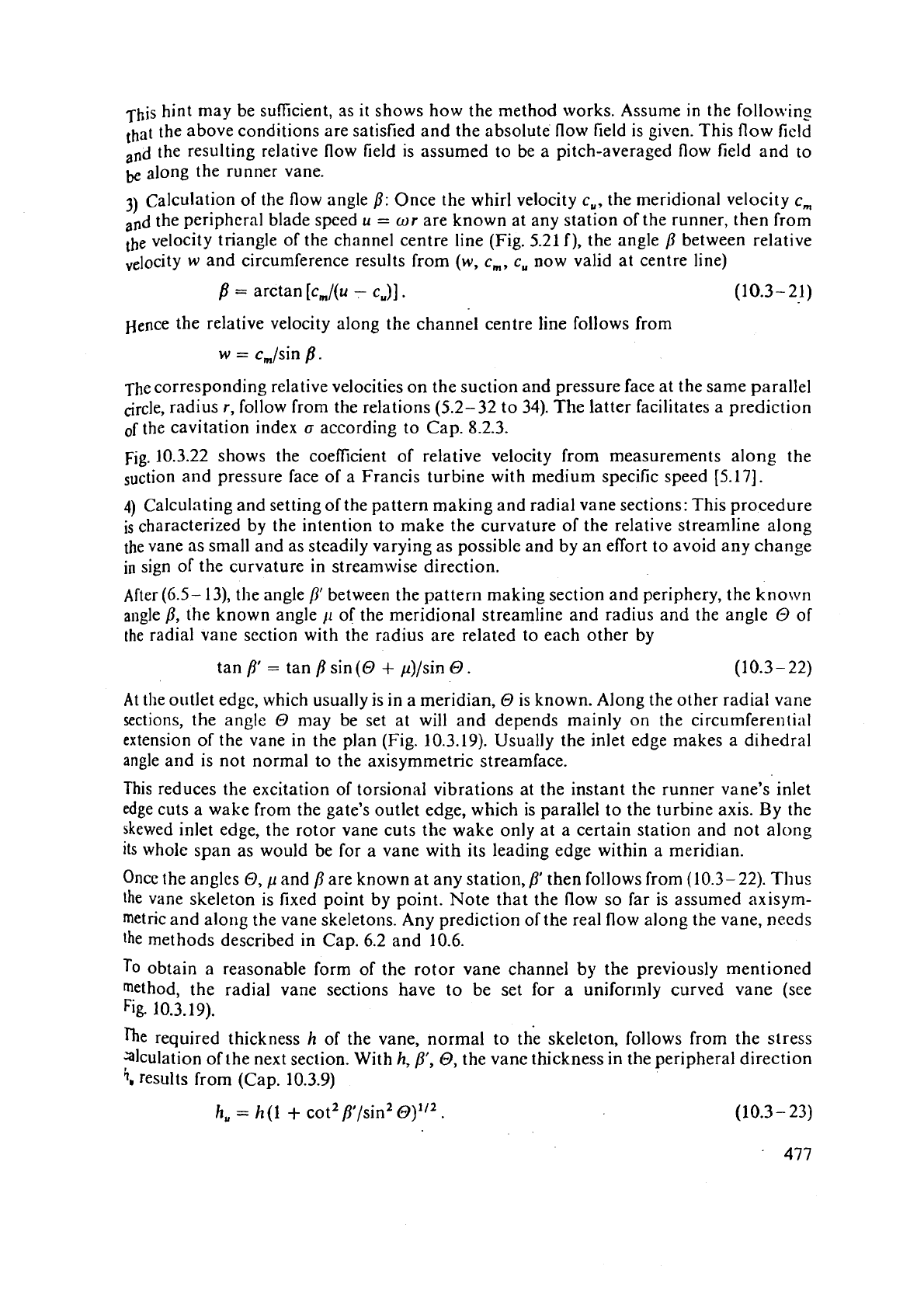
his
hint may be sufficient, as
it
shows how the method works. Assume in the folloivin~
that the above conditions are satisfied and the absolute flow field is given. This flow field
and
the resulting relative flow field is assumed to be a pitch-averaged flow field and to
be
along the runner vane.
3)
Calculation of the flow angle Q: Once the whirl velocity
c,,
the meridional velocity
c,
and
the peripheral blade speed
u
=
wr
are known at any station of the runner, then from
the velocity triangle of the channel centre line (Fig.
5.21
f), the angle
P
between relative
w
and circumference results from
(w,
c,,
c,
now valid at centre line)
B
=
arctan
[c,/(u
-
c,)]
.
(10.3-21)
Hence the relative velocity along the channel centre line follows from
The corresponding relative velocities on the suction and pressure face at the same parallel
circle, radius
r,
follow from the relations (5.2-32 to 34). The latter facilitates a prediction
of
the cavitation index
a
according to Cap.
8.2.3.
Fig. 10.3.22 shows the coefficient of relative velocity from measurements along the
suction and pressure face of a Francis turbine with medium specific speed
[5.17].
4)
Calculating and setting of the pattern making and radial vane sections: This procedure
is
characterized by the intention to make the curvature of the relative streamline along
the vane as small and as steadily varying as possible and by an effort to avoid any change
in sign of the curvature in streamwise direction.
After
(6.5-
13), the angle
between the pattern making section and periphery, the known
angle P, the known angle
11
of the meridional streamline and radius and the angle
O
of
the radial vane section with the radius are related to each other by
tan
p'
=
tan sin
(O
+
p)/sin
63.
(10.3-22)
At
the outlet edge, which usually is in a meridian,
O
is known. Along the other radial vane
sections, the angle
O may be set at will and depends mainly on the circumferel~tial
extension of the vane in the plan (Fig. 10.3.19). Usually the inlet edge makes a dihedral
angle and is not normal to the axisymmetric streamface.
This reduces the excitation of torsional vibrations at the instant the runner vane's inlet
edge cuts a wake from the gate's outlet edge, which is parallel to the turbine axis. By the
skewed inlet edge, the rotor vane cuts the wake only at
a
certain station and not along
its
whole span as would be for a vane with its leading edge within a meridian.
Once the angles
O,
p
and Pare known at any station,
jl'
then follows from (10.3-
22).
Thus
the vane skeleton is fixed point by point. Note that the
flow
so far is assumed axisym-
metric and along the vane skeletons. Any prediction of the real flow along the vane, needs
the methods described in Cap. 6.2 and 10.6.
TO
obtain a reasonable form of the rotor vane channel by the previously mentioned
method, the radial vane sections have to be set for
a
unifor~nly curved vane (see
Fig. 10.3.19).
The
required thickness
h
of the vane, normal to thk skeleton, follows from the stress
alculation of the next section. With
h,
Q',
0,
the vane thickness in the peripheral direction
i.
results from (Cap. 10.3.9)

Aclcli11.1
11,
2
ti11
ho[ll ~hc
i,tco,
of
tile \kclclotl iilonp its p;ltlcrll sec(iorr
in
circumgr
direction yiclcls tllc p:lrtcr~l scc~iv~l cli~c to tl~c re;11 si~ctit~~i
~LCC
:111d PrcSSur~
face
vanc.
10.3.7.
Sin~ple
strcss ct~lct~li~ti~n
of
a
runner
vane
Assume
;l
runner vanc to bc intersectcd
by
numerous acljnccnt cylindrical secti
Imagine that
:r11
thc bl:lclc sliccs so obt;~incd arc turned into one nicritiian. Thus the
b
is
trahsformed into
rr
r;~di;ll rib with the same
thickness
h,,
as thc rcnl blade
in
peripheral
direction
[Y.
1321.
This rib is consiticred
ah
a
beam loaded nornlally by the hydraulic load
component
in
tansential direction. Thc bean1 is clamped at both
of
i!s
cnds on the hub
and
shroud
rcspcctively so
as
to
be displaceable parallel to itself at the shroud's entl, see
[10.1541,
The
centrifugal
load is neglected, as it acts against the hydraulic ioacl. Its omission
has
to
Le
accounted for
by
an adequate choice of safety factor.
The clecibive peripheral force at start
up
is
derived from the known full load torque
-3
A,Il,,
=
P,il/u.
$
%1
According to the torque vs speed characteristic, the bta!-titi~ torque is
x,
times the
full
load torclue
(2,
being
1.3
to
2
for
11,
=
330
to
60).
The tangential force clue to this starting
torque is assumed to act on the rib, restrictetl as abovc.
on
the known pressure centre
of
the rotor vane,
on
:I
station a distance from its clnmpzd c11d at tile hub
(Fig.
10.3.23a).
This eivcs the
fixed
end Inonlent there
where
r,,
is the radics
OII
which the tan~eritial hydraulic load acts on the rib,
r,
accounts
for
thc diffcrer~t kincls of support possible at the shrouti's
cnti
of
the bennl. More exactly,
Fig.
10.3.23.
Stressing
of
a
FT
runner.
a)
Circular projection of runncr vane onto
a
meridian with
its
cerltrc of pressure
S
for
thc prriphcr;~l li!~droti~niirnic lu;id.
S
tierivcd
from
tlie mcnsuremcnt of
the
diiTcrentinl prcssarc
(I),,
-
p,)
(p!qII)
bet\\-een the prcssilrc. and suction I~cc, shown in
b).
b)
Dis!ribution of tlic diffcrc~itial prcssurc
,lp
in
the
bep
of
iI
FT
11,
=
70
(scc
Fig.
10.3.21).
From
Sclrlcnln~rr
[5.15].
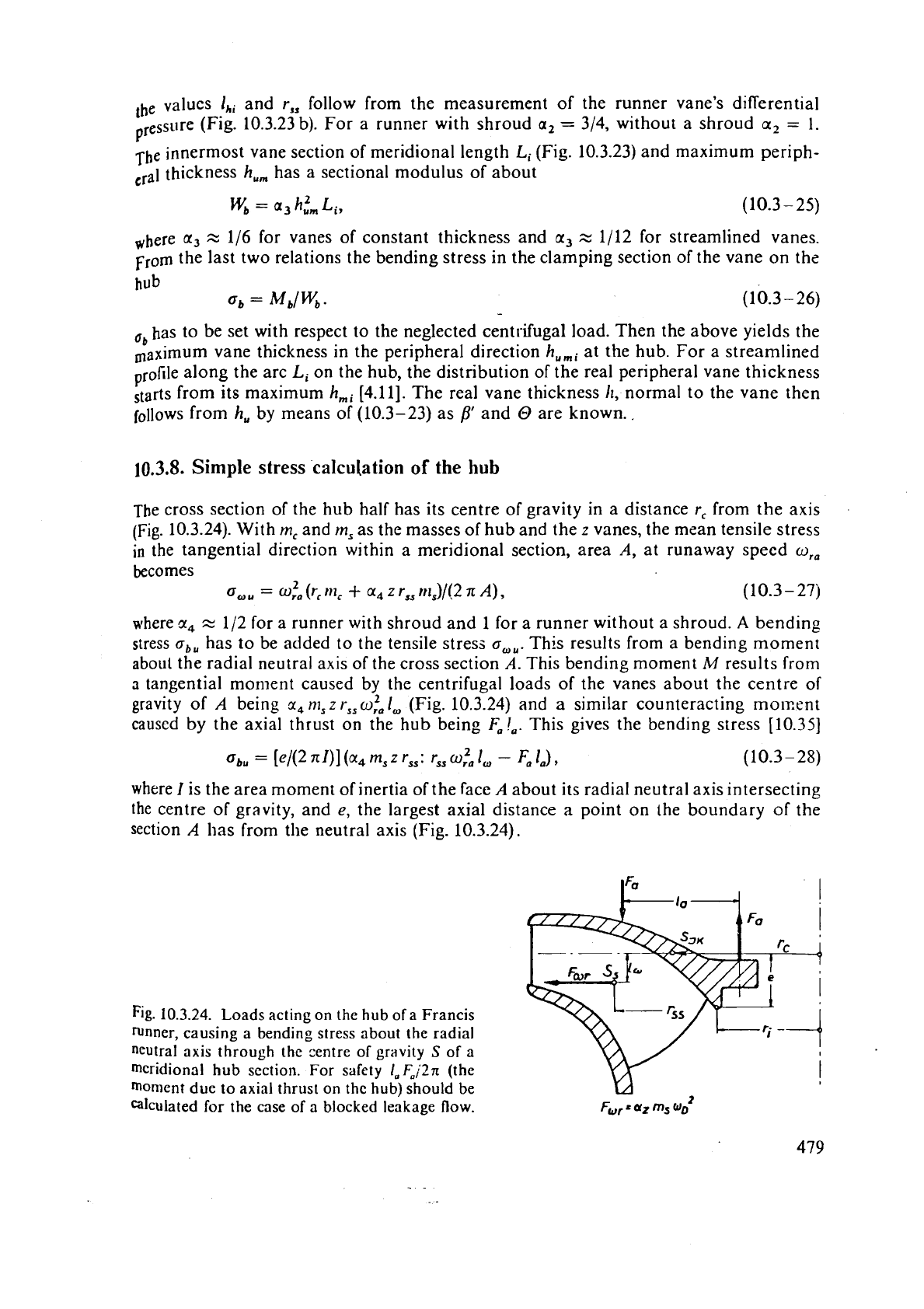
the values
lhi
and
r,
follow from the measurement of the runner vane's differential
Pr
essi~re (Fig. 10.3.23 b). For a runner with shroud
a,
=
314, without a shroud
a2
=
1.
The innermost vane section of meridional length
Li
(Fig. 10.3.23) and maximum periph-
cral
thickness
hum
has a sectional modulus of about
where
a,
%
116 for vanes of constant thickness and
a,
%
1/12 for streamlined vanes.
From the last two relations the bending stress in the clamping section of the vane on the
-
(lb
has to be set with respect to the neglected centrifugal load. Then the above yields the
vane thickness in the peripheral direction
hUmi
at the hub. For a streamlined
along the arc
Li
on the hub, the distribution of the real peripheral vane thickness
starts from its maximum
hmi
(4.111. The real vane thickness It, normal to the vane then
follows from
h,
by means
of
(10.3-23) as
jl'
and
O
are known..
10.3.8.
Simple stress
calculation
of
the
hub
The cross section of the hub half has its centre of gravity in a distance
r,
from the axis
(Fig.
10.3.24). With
m,
and
m,
as the masses of hub and the
z
vanes, the mean tensile stress
in
the tangential direction within a meridional section, area A, at runaway speed
or,
becomes
2
ow,
=
a,,
(r,
t11,
+
a4
z
r,,
nts)/(2
rc
A),
(10.3-27j
where
2,
=
112 for a runner with shroud and
1
for a runner without a shroud.
A
bending
stress
a,,
has to be added to the tensile stress
a,,.
This results from a bending moment
about the radial neutral axis of the cross section
A.
This bending moment
M
results from
a
tangential moment caused by the centrifugal loads of the vanes about the centre of
gravity of A being
r4
m,
z
I-,,
a:
I,
(Fig. 10.3.24) and a similar counteracting moment
caused by the axial thrust on the hub being
F,!,.
This gives the bending stress
[10.35]
where
I
is the area moment of inertia of the face A about its radial neutral axis intersecting
the
centre of gravity, and
e,
the largest axial distance
a
point on the boundary of the
section A has from the neutral axis (Fig. 10.3.24).
Fig.
10.3.24.
Loads acting on the hub of a Francis
runner, causing a bending stress about the radial
neutral axis through
the
centre of gravity
S
of
a
mcridional hub section. For safety
I,F0/2n
(the
moment due
to
axial thrust on
the
hub)
should be
calculated
for
the case of a blocked leakage flow.
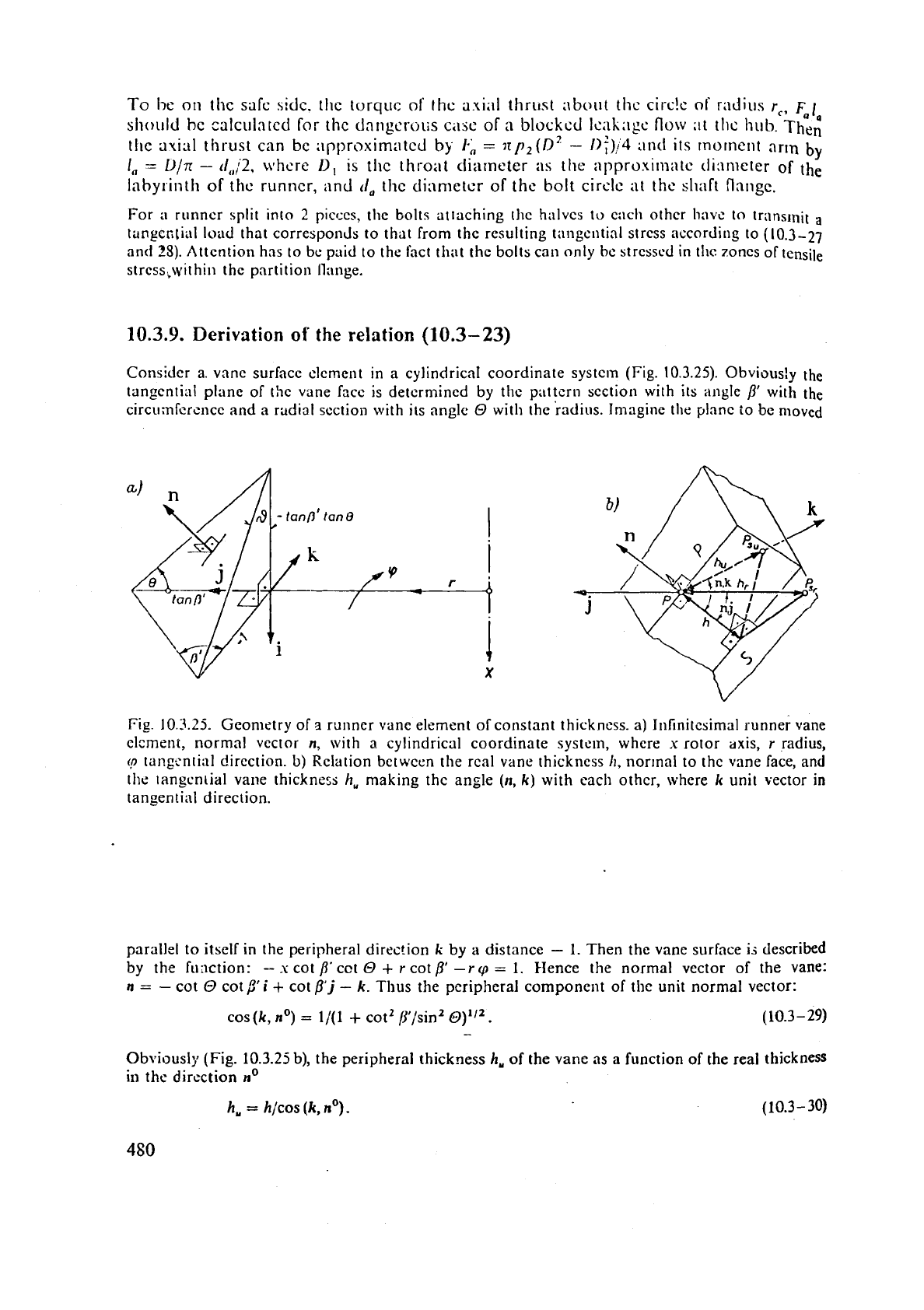
To
he
on
tllc safc side. rl~c torquc
ol'
thc axial thri~st
:tbout
thc
circ!c
of
radius
rc,
F
1
a
a
should
bc calculntcd for the dnngcrc>iis C,~X
of
n
blocked
Icahagc
flow
;~t
tl~
hub.
Then
tl~e axial thrust can bc :~pproxim;ltcd
by
I.:
=
ap,(~'
-
1);):~
and
its
rnolne~lt
nrln
by
I,
=
D/n
-
t1,,/2,
where
11,
is
the throat diameter
as
thc npproximntc tlianieter of
the
laby~.inlli
of
thc runncr, and
(1,
thc dinrnetcr
of
the bolt circle
at
the slii~ft Onngc.
For
;I
runncr split into
2
picccs, the bolts attaching tlic halves tu c:~cll other
~~IVC
10
tr;~nslnit
a
tangcclial
load
that corresponds to that from thc resulting tiingcntinl strcss according to
(10.3-27
and
25).
Attention has to be paid to the fact that thc bolts call only bc strcsscd in thc zoncs of tensile
strcss,,within thc partition Ilange.
10.3.9.
Derivation
of
the
relation
(10.3-23)
Considcr a. vnnc surfacc elcment in a cylindrical coordinate systcln (Fig.
10.3.25).
Obviously the
tangential plane of thc vane facc is detcrmincd by the pattcrn scction with its itngle
fit
with the
circuinfercncc and a radial scctioii with its angle
O
with the radius. Imaginc the plnnc io be moved
Fig.
10,3.25.
Geometry of
s
runner vane element of constant thickncss. a) I~~linitesimal runner vane
clcment, normal vector
n,
with
a
cylindrical coordinate system, where
s
rotor axis,
r
radius,
!D
tangential
direction.
b)
Relation bctwcen the real vane thickness
11,
normal to thc vane face, and
the ~angcnlial vane thickness
h,
making the angle
(n,
k)
with each othcr, where
k
unit vector in
tangential direction.
parallel to itself
in
the peripheral direc!ion
k
by a distance
-
1.
Then the vane surface
is
described
by
the filnction:
--
s
cot
fl'
ect
O
+
r
cot
P'
-rep
=
1.
I-lence the normal vector of the vane:
n
=
-
cot
O
cot
$'i
i-
cot
p'j
-
k.
TIlus the peripheral component of the unit normal vector:
cos
(k,
no)
=
1/(1
+
cot2 /3'/sin2
0)112.
(10.3-29)
-
Obviously (Fig.
10.3.25
b),
the peripheral thickness h, of the vane as a function of the real thickness
in
thc direction
no
h,
=
hlcos
(k,
no).
(10.3-30)
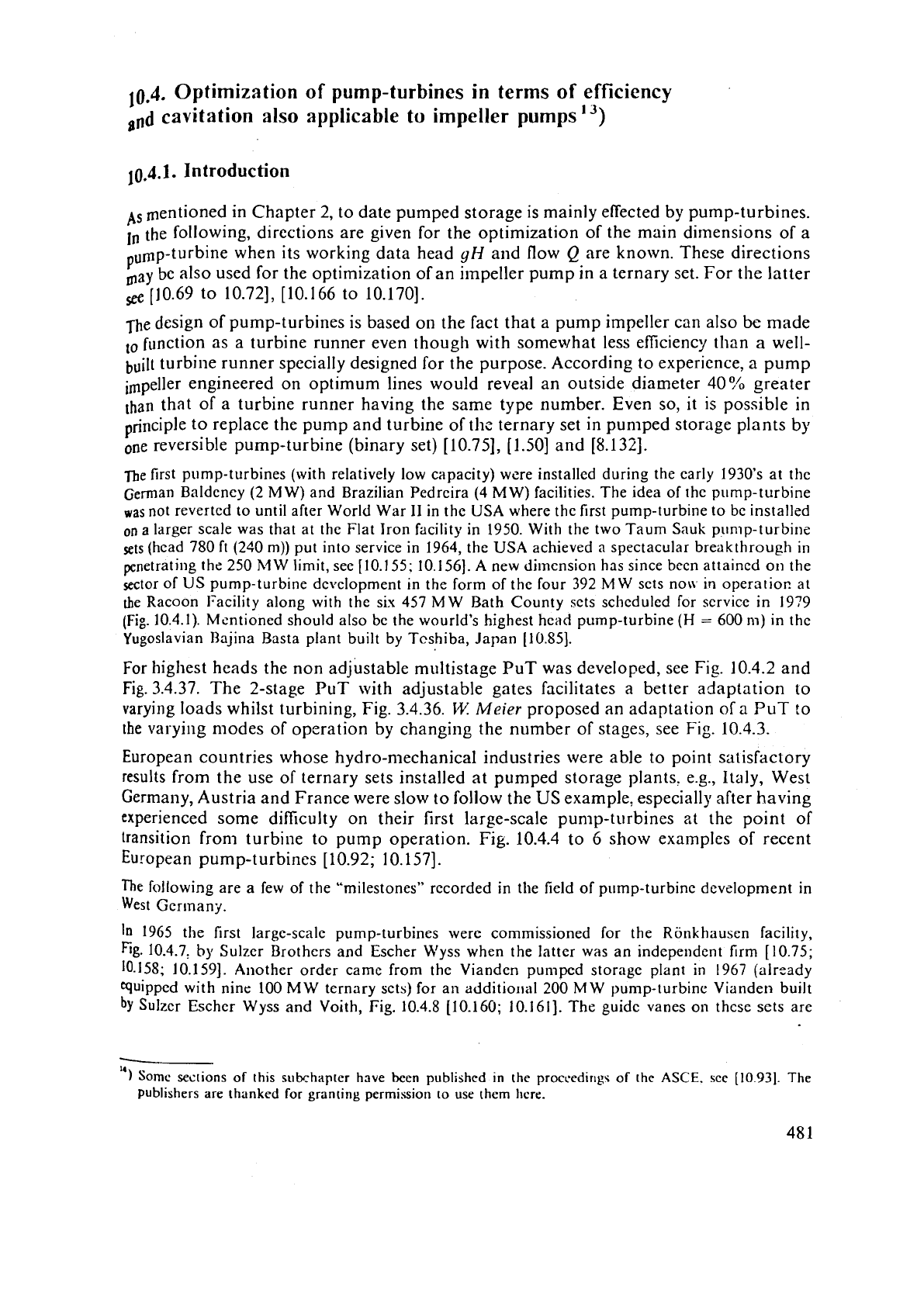
10.4.
Optimization of pump-turbines in terms of efficiency
cavitation also applicable
to
impeller pumps
13)
10.4.1.
Introduction
ps
mentioned
in Chapter
2,
to date pumped storage is mainly effected by pump-turbines.
the following, directions are given for the optimization of the main dimensions of a
pump-turbine when its working data head
gH
and flow
Q
are known. These directions
may be also used for the optimization of an impeller pump in a ternary set. For the latter
6
[10.69 to 10.721, [10.166 to 10.1701.
ne design of pump-turbines is based on the fact that a pump impeller can also be made
to
function as a turbine runner even though with somewhat less efficiency than a well-
built
turbine runner specially designed for the purpose. According to experience,
a
pump
impeller engineered on optimum lines would reveal an outside diameter 40% greater
than that of a turbine runner having the same type number. Even so, it is possible in
principle to replace the pump and turbine of thc ternary set in pumped storage plants by
one reversible pump-turbine (binary set) [10.75], [1.50] and [8.132].
The first pump-turbines (with relatively low capacity) were installed during the early 1930's at the
German Baldcney
(2
MW) and Brazilian Pedreira
(4
MW) facilities. The idea of the pump-turbine
was
not reverted to until after World War
I1
in the
USA
where the first pump-turbine to be installed
on
a larger scale was that at the Flat Iron facility in 1950. With the two Taum Sauk pump-turbine
sets
(head 780
ft
(240 m)) put into service in 1964, the USA achieved a spectacular breakthrough in
penetrating
the 250
MW
limit, see [10.155; 10.1561.
A
new dimension has since been attained on the
sector of US pump-turbine development in the form of the four 392
M
W
sets non in operatior. at
he
Racoon 17acility along with the six 457
MW
Bath County sets scheduled for service in 1979
(Fig. 10.4.1). Mentioned should also
be the wourld's highest head pump-turbine
(H
=
600 n~) in the
Yugoslavian
Bajina Basta plant built by Tcshiba, Japan [10.85].
For highest heads the non adjustable multistage PUT was developed, see Fig. 10.4.2 and
Fig.
3.4.37. The 2-stage PUT with adjustable gates facilitates a better adaptation to
varying loads whilst turbining, Fig.
3.4.36.
IT
Meier
proposed an adaptation
of
a PUT to
the
\larying modes of operation by changing the number of stages, see Fig. 19.4.3.
European countries whose hydro-mechanical industries were able
to
point satisfactory
results from the use of ternary sets installed at pumped storage plants.
e.g., Italy, West
Germany, Austria and France were slow to
follo\v the
US
example, especially after having
experienced some difficulty on their first large-scale pump-turbines at the point of
transition from turbine to pump operation. Fig.
10.4.4 to
6
show examples of recent
European pump-turbines
[10.92; 10.1571.
The
following are a few of the "milestones" recorded
in
the field of pump-turbine development in
West Germany.
In 1965 the first large-scale pump-turbines were commissioned for the Ronkhausen facility,
Fig.
10.4.7,
by
Sulzer Brothers and Escher Wyss when the latter was an independent firm [10.75;
10.158; 10.1591. Another order came from the Vianden pun~ped storage plant in 1967 (already
quipped with nine 100 MW ternary sets) for an additio~lal 200 MW pump-turbine Vianden built
by
Sulzer Eschcr Wyss and Voith, Fig. 10.4.8 (10.160; 10.1611. The guide vanes on thcse sets are
-
''1
Some sections of this subchapter have been published in the proccedir~gs of the
ASCE.
sce
[10.93].
The
Publishers are thanked for granting permission to use them
Ilcrr.
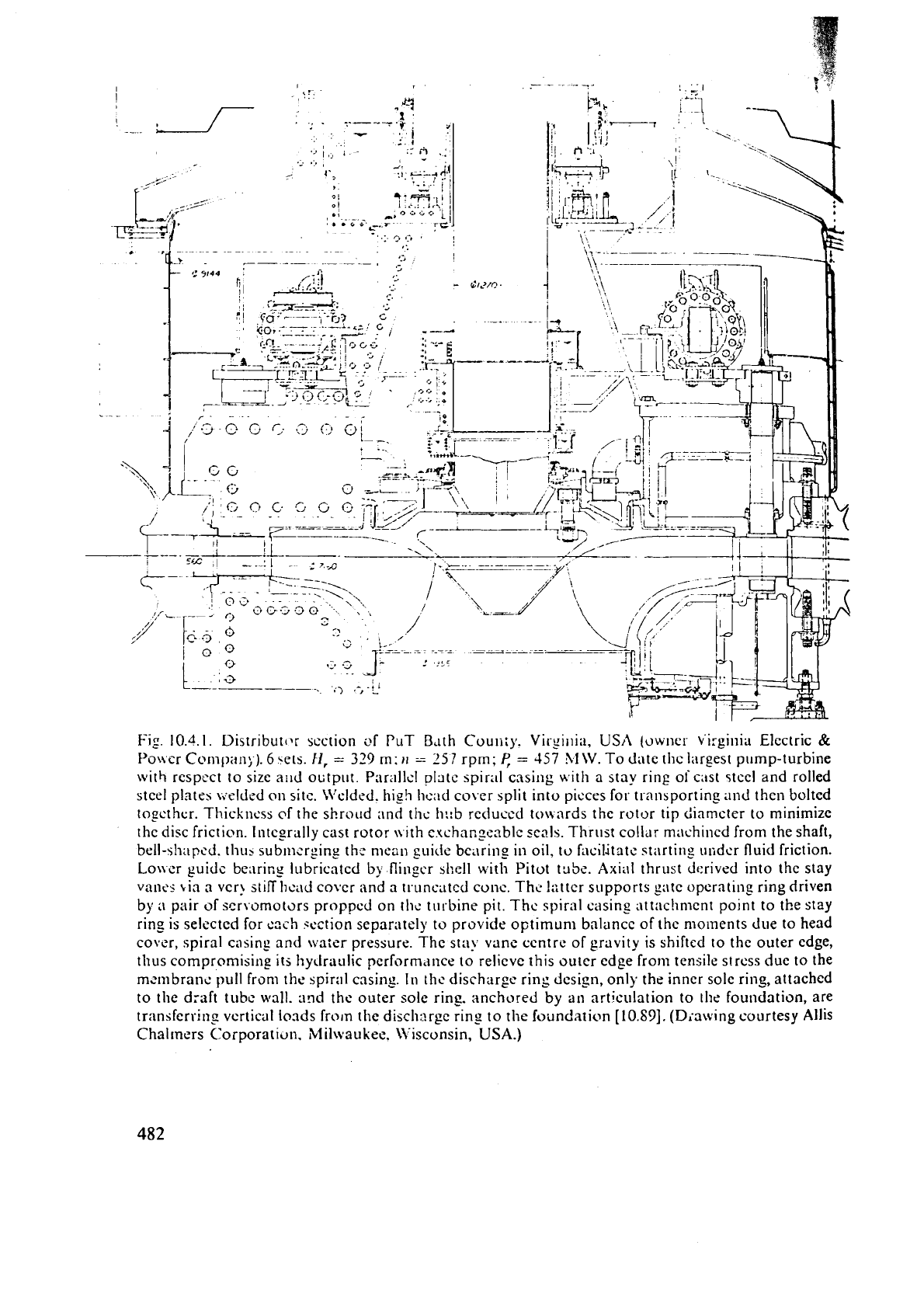
Fig.
10.4.1.
I)istributc>r
section
~f
PUT B'lth COUII;~. Virgiili;~,
USA
(owner ~.i:ginia Electric
&
PoIvcr Company).
6
wts.
[I,
=
329
rn;
u
=
257
rpm;
P,
=
457
W.
To date tlic Iitrgest pump-turbine
with
respect to size arid o~tput. Parallcl plat? spiral casing with a stay ring of cast 5tccl and rolled
stcel plates v;eldsd on sitc. \\'eldc.d. hish hc;td cover spIit into picces for transporting
and
then bolted
toguther. Thickness of the shroud and tllc h::b rcduccd towards the rotor tip diameter to minimize
the disc friction.
Integrally
cast rotor with exuhangenblc scnls. Thri~st collar machincd from the shaft,
bell-shapcd. thus sub~ncrging the mean guitie bearing
ill
oil, to facilitate starting i~nder fluid friction.
L0bvi.r guidc bearicg lubricated
by
.flinger
sl?ell with Pitot tube. Axial thrust derived into the stay
vanes
via
a
vcr! stifll~cad cover and
3
trunc~ttcd cone. Thc
!titter
silpports g:ttc operatill ring driven
by
;I
pair of ser\.omotors propped on
tlil:
turbine pit. Thc spiral casins uttac!iment point to the stay
ring is selected for
exh section separritely to provide optimum balance of thc nioinents due to head
cover, spiral casing and pressure. The
sta vane centre of gravity is shifted to the outer edge,
tlius con~pron~isi~l_p its I?y~Ira:~lic pcrformnnce to relicvc this outer edge from tensile strcss due to the
mcmbranc pull from the spiral casing.
In
the dischargc ring design, only the inncr sole ring, attached
to the
draft tube wall.
and
the outer sole ring. anchored
by
an
articulation to the foundation, are
transferrins vertical loads from the disch:?rgc rins to the foundation
[lO.S9].
(Diawing courtesy Allis
Chalrners Corporation.
IM
ilwaukee, li'iscunsin,
USA.)
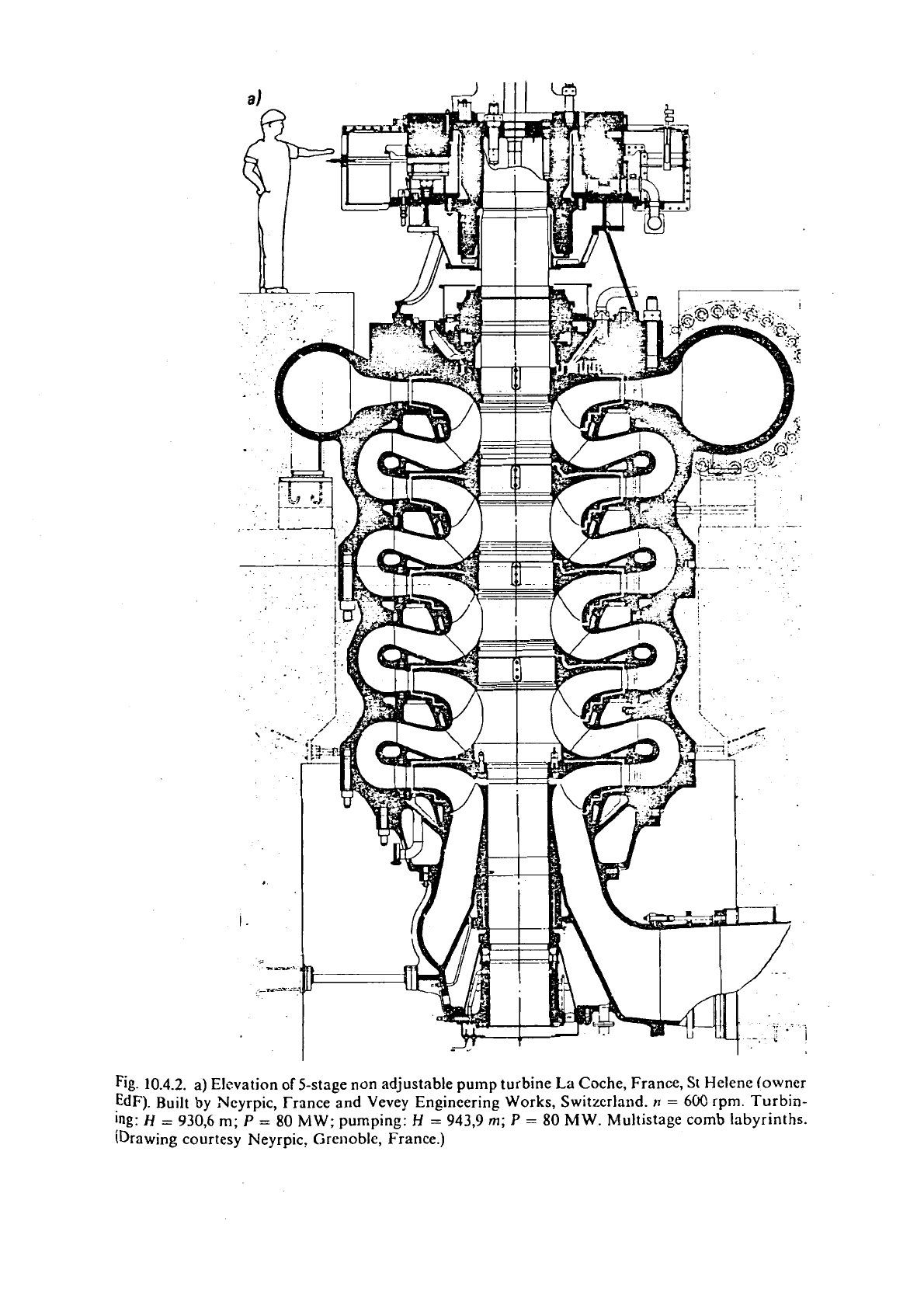
Fig.
10.4.2.
a) Elevation
of
5-stage non adjustable pump turbine
La
Coche, France,
St
Helene (owner
EdF). Built by Ncyrpic, France and Vevey Engineering Works, Switzerland.
n
=
600
rpm. Turbin-
Ing:
H
=
930,6 m;
P
=
80
MW;
pumping:
H
=
943,9
m;
P
=
80 MW. Multistage comb labyrinths.
(Drawing courtesy Neyrpic, Grenoble, France.)

Fig.
10.4.2.
b) Runncr and shaft in Vcvcy Engineering Works. Note the skcwcd outcr edges of the
rotor vanc faces to rcduce the excitation of torsional vibrations and diffuser bladc stall by means
of
wakes. (Photograph ccurtesy Vevey-Charmilles Engineering Works, Switzerland.)
operated by individual servomotors, and the motor-generator
set is also capablc of spccding up the
watcr-filled pump-turbinc into pumping action from the stationary phase with closed valve.
In
1972
two
75
hfW
pump-turbines were purchased from Voith for the Langenprozclten facility
(1;ig.
10.4.9)
a power station serving to generate single phasc traction power for the Federai Railway
of \ilcst Germany. For the purpose of speeding up thc pump-turbine into pumping action, provision
was
made in this casc for
a
27
bl
W
Francis turbine designed on simple lincs by Sulzer Escher Wyss
to function as
a
starting turbine
[10.162; 10 1631.
In
1972
thc
250
MW
Rodund pump-turbine, Fig.
10.4.10 [10.164],
was ordcrcd from Voith
to
cornplcment existing
ternary
sets in servicc at the Austrian Liincrsec and Rodund
1
pumped storage
plants. The
head in this case amounts to
1140
ft
(350
m).
r2ccording to
[277]
thc further development of bep delivery head H,,.and rnaximi~m input
P,
of PUTS,
ordered from Voith in the year indicated, is shown by the
following
plants: Coo, Belgium,
1975,
H,,
=
26s
m,
P,
=
206
MW;
Kuhtai, Austria,
1976,
lf,,
=
409
m,
P,
=
122
MW,
Obravak, Yugosla-
via,
1979,
H,,
.=
548
in,
P,
=
123
blW.
Modern trends in the design of pump-turbines are given in
[10.76; 10.77; 10.80; 10.811.
Quite a
number of
papers have already been written
on
the subject of existing pump-turbines or pumped-
storage sets of which only a brief selection can be cited here
[10.103; 10.106; 10.157; 10.162; 10.165;
10.166; 10.167; 10.168; 10.169;
10.170].
Normally such treatises are concerned with the distinguishing features of a certain plant.
This
being
the case, there appears to be some necessity to approac:~ the subject of pump-turbine design from
a more general theoretical angle based on practical results.
The principal objective of this chapter is to draw dttention to a decisive factor, namely
tha: of the costs rising from excavation work and mechanical losses occurring during the
period of operation.
The key to the optimum design of the impeller (the actual centerpiece of
a
pump-turbine)
is a new process applied
to
computing the type nuinber of a semi-axial pump-turbine.
Type number is fu~lctionally related to empirical loss coefficien:~ (aerodynamics also
being drawn upon for purposes of analogy), cavitation factors, operating characteristics
such as flow rate and head, as well as
kcown geon~etrical dimensions of the impeller and
diffuser.
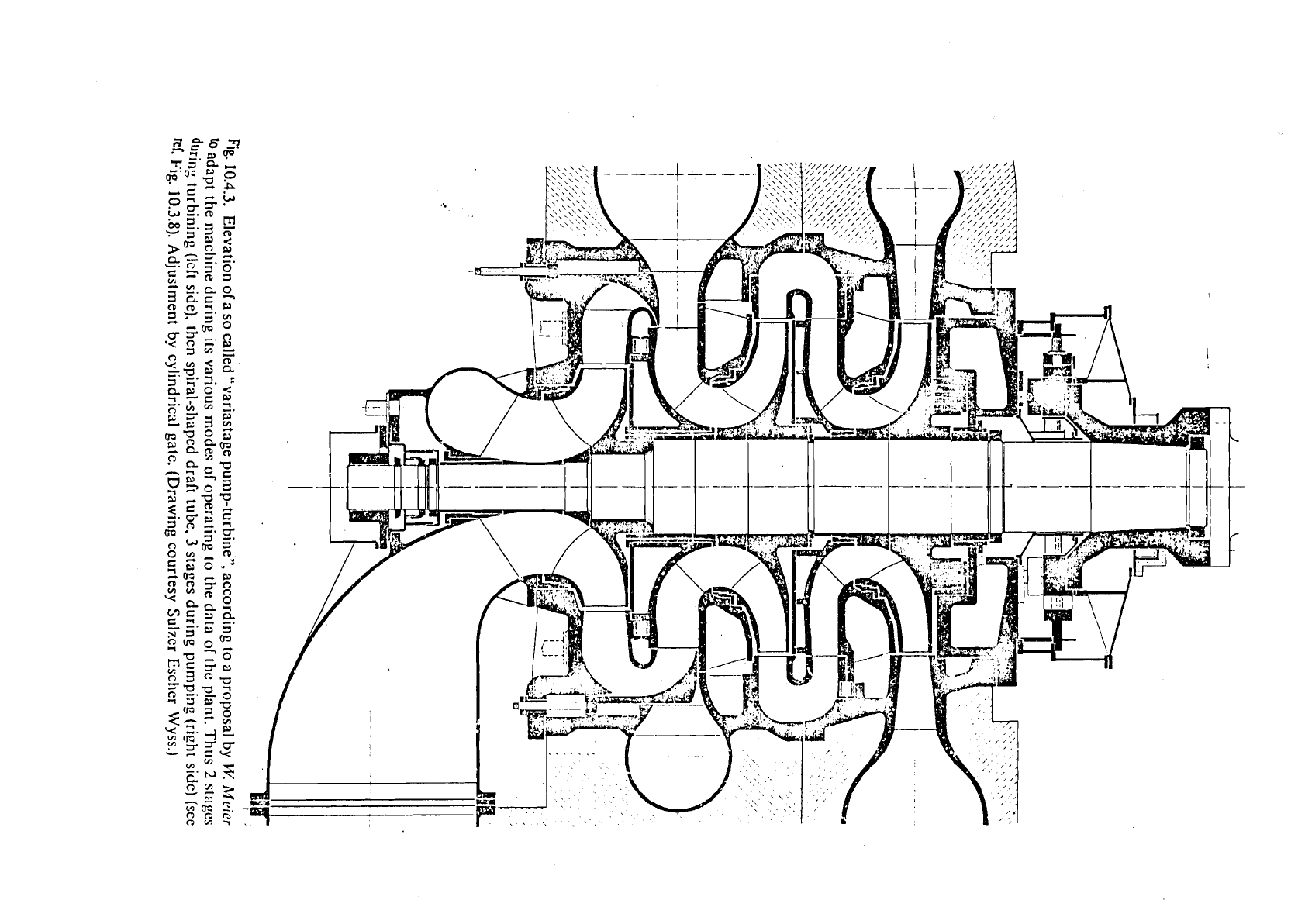
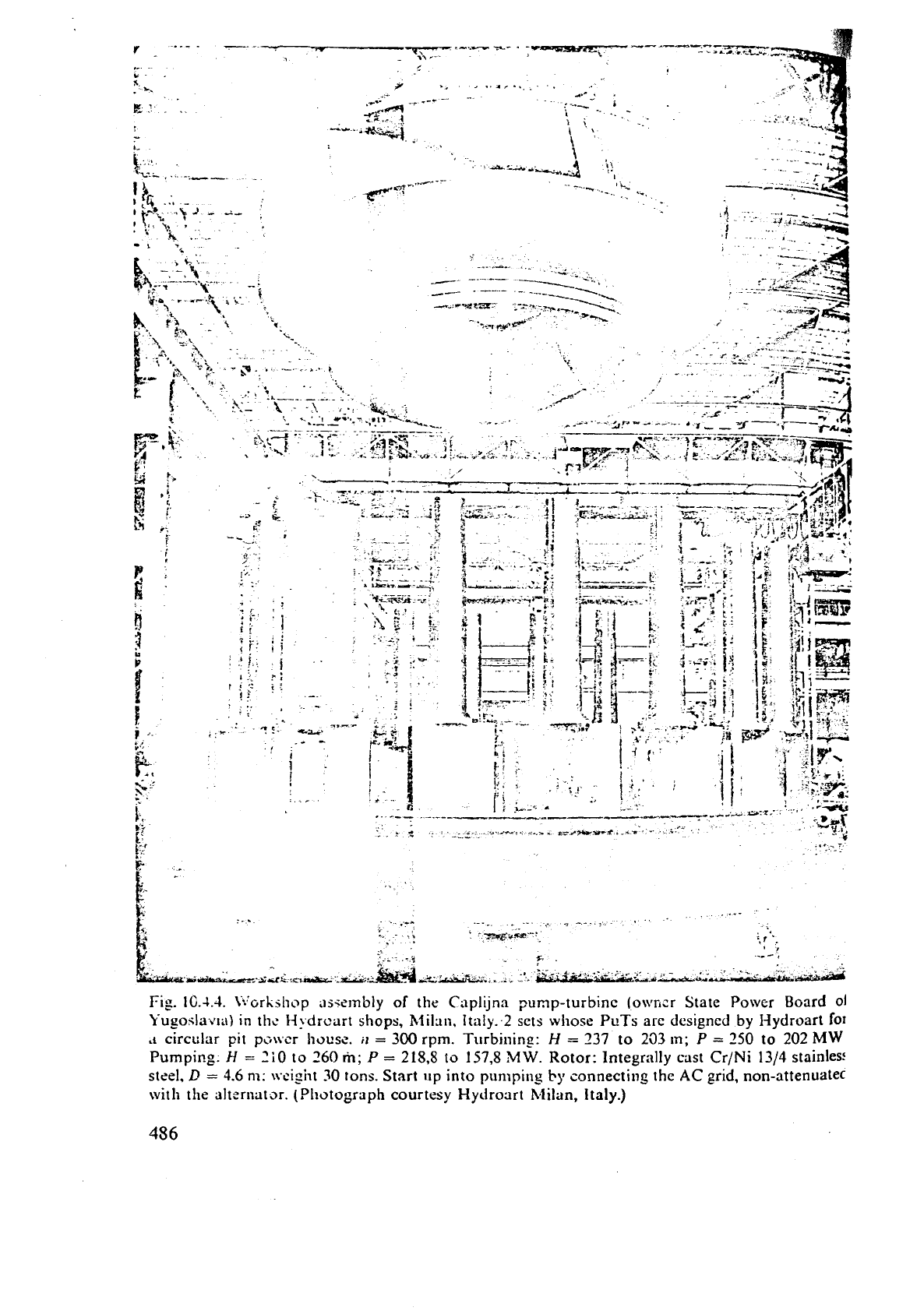
Fig.
lC.4.4.
i\'orhshop ,~s.;ernbly of the C'lplijna pump-turbinc (o\vn;r State Power Board
01
Yugo.;la,-la)
in
the H:drcart
shops,
hlilan. Italy.
2
sets whose
PuTs
arc designed
by
I-lydroart
for
.I
circular pit
pcmcr
housc.
,I
=
300
rpm. Turbinin_g:
H
=
237
to
233
m;
P
=
250
to
202
MW
Pumping.
H
=
2iO
to
260
m;
P
=
218,s
to
157,s
MW.
Rotor: Integr:~lly cast Cr/Ni
1314
stainlest
steel.
D
=
4.6
ni:
\wight
30
tons. Start
up
into pumping
by
connecting the AC grid, non-attenuatec
with
the
alternatar.
(Pl~otograph
courtesy Hydroart hlilan,
Italy.)
